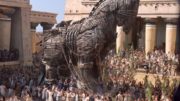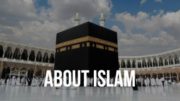We ended the last article with an overview of some of the religions that influenced Islam. This article will begin by looking at the some of the things Islam borrowed from those religions and then some relevant cultural aspects of the Arabic people.
Islam’s Borrowings
The list of Islamic borrowings below is not complete, but does show how extensive they were. This view is reinforced by the words of Ignaz Goldziher who wrote the following early in the twentieth century, ‘The dogmatic development of Islam took place under the sign of Hellenistic thought; in its legal system the influence of Roman law is unmistakable; the organization of the Islamic state as it took shape during the ‘Abbasid caliphate shows the adaptation of Persian political ideas; Islamic mysticism made use of Neoplatonic and Hindu habits of thought. In each of these areas Islam demonstrates its ability to absorb and assimilate foreign elements so thoroughly that their foreign character can be detected only by the exact analysis of critical research.
‘With this receptive character Islam was stamped at its birth. Its founder, Muhammad, did not proclaim new ideas. He did not enrich earlier conceptions of man’s relation to the transcendental and infinite … The Arab Prophet’s message was an eclectic composite of religious ideas and regulations. The ideas were suggested to him by contacts, which had stirred him deeply, with Jewish, Christian, and other elements, and they seemed to him suited to awaken an earnest religious mood among his fellow Arabs. The regulations too were derived by foreign sources; he recognized them as needed to institute life according to the will of God.(1)
From Zoroastrianism –
- Merit is earned by reciting verses from the Avasta (holy text) to relieve demerits earned in life.
- The Mizan – a balance where the actions of men are weighed to determine whether they go to Paradise or Hell.
- The recitation of daily prayers. Islam initially had two sets of daily prayers, then went to three (based on the Jewish schedule), and then to five (based upon the Zoroastrian schedule).
- Muhammad’s ascent from Jerusalem is very similar to the Pahlavi Artay, written sometime in the fourth century.
- Zoroastrianism is the official religion of Persia, and prevalent among the aristocrats and military. A Caliph is the head of this religion. The church and state are one.
- The concept of the Road or Path (Sirat); the right way of religion. This is also used to refer to the razor thin bridge between heaven and hell that the unrighteous cannot pass on the final day of accounting.
- The descriptions of what Paradise is like, which is fully of physical pleasures.
- Some Persian words are included within the Qur’an as there were no equivalents in the Arabic language for them. Research puts between 107 and 275 foreign words within the Qur’an that come from Aramaic, Hebrew, Syriac, Ethiopic, and Greek in addition to Persian.
From Judaism –
- Concept of monotheism.
- Muhammad claimed to be the final fulfillment of the line of prophets from the Old Testament that began with Moses.
- Facing the Holy City for prayers (initially Jerusalem and later Mecca).
- Rabbinical words contained within the Qur’an where no Arabic equivalents existed.
- The rabbinical writings from the Talmud (written about 200 AD) form the basis of many of the stories contained within the Qur’an such as:
- A raven sent to Cain after his killing Abel in Genesis.
- The murder of an individual is equivalent to the killing of a whole race.
- Religious doctrines.
- The unity of God, although as we’ll see later the Islamic concept of Allah was heavily influenced by the Neoplatonist writings of Plotinus.
- Written revelation.
- Six days for creation, although the Qur’an is inconsistent in the number of days taken for creation.
- The existence of seven heavens and seven hells (this also appears within Zoroastrianism).
- Mount Caf being the highest point on the Earth – A misunderstanding of the translation of the word ‘thohu’ from the Hagagah.
- One of the stories of the creation of Adam comes from the Midrash Rabbah.
- The angels being ordered to worship Adam.
- The story of Cain and Abel.
- Gog and Magog.
- Noah’s character and conversations within Surah 7 comes from the rabbinical writings in Sanhedrian 108.
- The boiling water said to be used in the Flood as punishment in Surahs 11 and 33 come from Rosh Hashanah 16.2 and Sanhedrin 108.
- Solomon commanding demons and tricking them into building the Temple in Jerusalem in Surah 34 appear in Gittin 68. There are many more examples that could be cited.
Nestorian –
- Jesus was only a man inspired by God.
Gnosticism –
- From the Coptic History of Mary and Protevangelium of James the Less, that Jesus was born under a palm tree and asked the tree to provide its fruit to Mary.
- The making of clay birds and breathing life into them and speaking at birth to defend Mary’s honor from the Gospel of Thomas.
- Christ was only a prophet.
- The Trinity consists of God, Christ, and Mary.
- From the Basilidians, Jesus was not crucified. God would not let a prophet die such a humiliating death. Instead God substituted someone who looked like Jesus, and took Jesus directly up into heaven. Jesus even stood by and laughed while the wrong man suffered in his place.
- The story of the Seven Sleepers of Ephesus from James of Sarug (Syrian bishop) is contained within the Qur’an.
Paganism –
- Pagan practices kept by Islam include slavery, polygamy, easy divorce (for the man), demonic pollution, and ritual cleansing.
- Existence of Jinns.
- The folk tales of Ad and Thamud.
- The Hajj is almost entirely taken from pre-Islamic pagan rituals that were familiar to Arabs and centered on the Kaaba in Mecca. These include:
- The pilgrimage occurring during the sacred month of Ramadan.
- The kissing of the Black Stone, Arab pagan gods often resided in stones.
- Circumambulating the Kaaba seven times, three times fast and four times slow, representing the seven known planets. Each time kissing another stone in the Yamani corner of the Kaaba (this is the side of the Kaaba facing the Yemen.)
- Running from the Kaaba to the top of As Safa and then to and from Al-Marwah (another hill) seven times. The purpose of this run in pagan times was to kiss the stones Isaf and Naila located on the top of each hill.
- Casting of seven stones at each of three pillars in the village of Mina, just east of Mecca.
Christianity –
- All people will experience death and an intermediate state.
- The return of Jesus.
- A resurrection prior to the final day of judgment.
- A final day of judgment for all people.
The People
At the beginning of the sixth century, the Arabian Peninsula was peopled by two groups. The Saracens in the north and in the Hijaz, and the Sabeans in the south. The Saracens consisted of two sub-groups. One was both nomadic and semi-nomadic (Bedouins), and the second sub-group was settled. The Bedouins generally raised animals such as goats, sheep, or camels. They migrated based upon the availability of grazing land, and followed annual routes as their ancestors had done. They relied on trade with the settled communities for food and metal items such as weapons, and they also excelled in fighting. Bedouins supplemented their own wealth with raids on settlements and caravans, and also extorted protection fees from some communities. Fighting was also considered to be a form of entertainment, a game that reduced the monotony of dessert life. The nomadic groups were usually family groups of not more than two dozen people or so. Clans and tribes rarely gathered together in large groups, and then not for very long.
The settled sub-group of Saracens generally farmed, mostly raising figs and dates. Farming required irrigation in all parts of Arabia except the southwestern parts of the peninsula in what is now Yemen. Most of the settled communities in the Hijaz and north were around oases. They traded both with the Bedouins and with the outside world through caravans to obtain what they could not produce for themselves. The caravans contributed to the wealth of these communities not only through the trade that was conducted, but also through hiring on as drivers and workers in the caravans, supplying the caravans, and selling safe passage. Jewish tribes also had land holdings in many of the most prosperous locations, such as Khaybar, Mecca, Yathrib (Medina), Taima, and Fadak. The Jewish and Arab tribes lived together in these communities.
The two sub-groups of Saracens were in conflict. The settled tribes often paid protection to a particular Bedouin clan to keep them safe from other tribes. These alliances changed, shifting based upon the current needs of each particular tribe. Life was very difficult as often not enough goods could be created to maintain living conditions. Society itself was organized around the tribe, and the tribes were the ruling authority as it existed at this time in Arabia. Although the ties of tribal blood held society together, this was slowly changing and being replaced by common self-interest through trade associated with merchants and agriculture.
The quality known as muruwa (virility) was paramount within Arabic society. This trait was reflected by honor, courage, endurance, loyalty to one’s group (tribe and/or clan), and one’s social obligations. Muruwa could be increased by creating alliances beneficial to one’s tribe or performing heroic acts. Infringements of this moral code rendered the individual liable to insults and the loss of honor. Blood feuds were frequent and required if one’s muruwa was impugned. The killing outside of one’s clan wasn’t viewed as necessarily bad. It depended upon whether the results were judged to achieve a good end for the tribe. Relations between tribes had generally been held together by blood and mutual self-interest.
Here are two quick examples that highlight some of the cultural differences between the Arabic peoples and the West. The first example is the making of a vow. In the west this is normally a solemn promise, sometimes one made to God. The intent of the person making the vow is to keep it, no matter what happens. Within the Arabic culture, we have the following sentiment from a 13th century poet, ‘What good is a vow if there is no way out.’ This isn’t good or bad in itself, but is simply a reflection of their environment, where needs could change rather abruptly so commitments needed to be flexible as well. The survival of one’s clan could depend on it.
The second example relates to what one should do if they got into an argument with a friend, and later found out that they were in the wrong. In the West, the person who was wrong would normally apologize. However, the following adage comes from Eastern culture. ‘To have a fault is one fault, to admit a fault is two faults.’ Again, a very different cultural standard, neither right nor wrong but simply different.
The Sabeans had a well-developed culture with their own architecture, written language, and legal system. They had significant seaports that traded with India and eastern Africa. In addition to trade they also raised crops, cattle, and grew trees for perfumes and spices. They were primarily pagan but the area around Najran was formerly a Jewish kingdom and by the early sixth century was peopled primarily Christians. In comparison with most of the Saracens, they lived fairly wealthy and peaceful lives.
Summary
To summarize, the following are this article’s main points. First, Islam borrowed heavily within the religious sphere, but this same degree of borrowing also occurred within other aspects of Islam such as law and governance. Second, conflict was prevalent within the Arabic culture, and this conflict was often driven by the scarcity of goods and the speed at which wealth could disappear. Alliances had to shift with changing needs in order to survive. This played itself out in other significant cultural differences that must be understood in order understand Islam. Third, the ties of kinship were paramount in Arabia early in the sixth century. However, this was changing and being replaced by economic ties and mutual self-interest by the later part of the century when Muhammad was born.
This ends the second background article on Arabia and its people. In the third and final background article we will take a look at Arabic ancestry, language, and some common practices. After that we’ll pick up with Muhammad’s life and teachings.
DOWNLOAD PDF
 Author and speaker, Dan Wolf, is gifted at gathering facts about contemporary subjects and sharing information in a manner that is easy to read and understand. Dan will be posting both historical and current information about Islam and Sharia on the VCA website.
Author and speaker, Dan Wolf, is gifted at gathering facts about contemporary subjects and sharing information in a manner that is easy to read and understand. Dan will be posting both historical and current information about Islam and Sharia on the VCA website.




